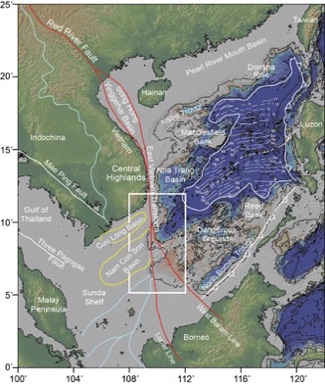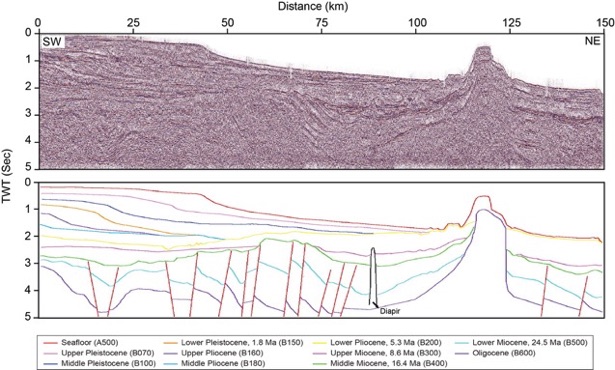
Tectonics of the Vietnam Margin
Understanding the processes that operate during the breakup of a continent to form a new ocean basin remains a point of debate for geologists. In the South China Sea we have the opportunity to see how a new basin migrated from northeast to southwest and test whether there were linkages between that and the motion on major faults in Indochina, especially the Red River Fault, which some workers believe allowed Indochina to move towards the south east relative to mainland China. I focus on work in the marine offshore using released industrial seismic and drilling data, largely located offshore Vietnam to understand how basins form in this environment and what causes them to fill with sediment. This work currently forms a PhD thesis topic for student Lu Li.
We use a combination of backstripping of interpreted seismic profiles combined with forward modeling based on the brittle extension observed in the crust to see the extent of depth dependent extension during and after breakup. in particular we are interested in lower crustal viscosity and the strength of the plate in determining basin morphology, heatflow and subsidence patterns. the tectonics of this part of the South China Sea are complicated by the strike slip tectonics of the East Vietnam margin, the propagating rift, as well as the collision of the Dangerous Grounds and Borneo around 16 Ma.
Seismic profile across the Sunda Shelf, into the deep water basin offshore southern Vietnam. Notice the prominent eastward migrating clinoforms that represent the submarine delta of the Mekong River, but with an important additional flux from the Malay Peninsula and from Borneo, especially during sea level lowstands via the Mollengraaf River. Our data now constrain the age of the Mekong Delta to be approximately 8 Ma, which correlates roughly with the uplift of the Central Highlands of Vietnam. it is possible that the Mekong used to drain into the Gulf of Thailand before this time and has experienced captured to be in the present position.
Note also the prominent seamount volcano positioned at 120 km. This seamount is part of extensive complex of relatively young volcanic features that are found throughout the South China Sea and which have been linked to a regional mantle thermal anomaly. Our subsidence analysis suggests no significant depth anomaly in this region and therefore little support for there being a major hot, deep-seated plume feeding volcanism across the region over the last few million years.
This project is made possible thanks to support from PetroVietnam and the Vietnam Petroleum Institute through a memorandum of understanding to Louisiana State University.
Nam Con Son Basin and the Southwestern South China Sea

